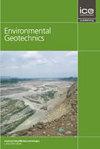干湿循环对SAP预脱水尾矿脱水的影响
IF 2.2
4区 工程技术
Q3 ENGINEERING, GEOLOGICAL
引用次数: 0
摘要
本研究的主要目的是了解用高吸水性聚合物(SAP)预脱水的流体细尾矿(FFT)在干湿循环中的干燥行为。原始FFT(对照)和含SAP的预脱水FFT经历5个湿润周期和6个干燥周期。研究发现,蒸发是生FFT脱水和SAP预脱水的主要机制。在这两种情况下,每个干燥周期中产生的吸力都被随后的湿润周期暂时消除。柱内最小固含量约为70%,对应的叶片抗剪强度为4.5 kPa。基于表面数字图像,计算出原始FFT和预脱水FFT的裂纹强度因子分别为26%和14%。扫描电镜和压汞孔隙度分析表明,第二次举升蒸发25 d后用SAP预脱水的FFT结构最致密。经SAP预脱水的FFT固相含量由最初的50%提高到98%。SAP预脱水方法可显著提高FFT的干湿循环抗剪强度。本文章由计算机程序翻译,如有差异,请以英文原文为准。
Effect of wetting-drying cycles on the desiccation of tailings pre-dewatered with SAP
The main objective of this investigation is to understand the desiccation behaviour of fluid fine tailings (FFT) pre-dewatered with a superabsorbent polymer (SAP) with respect to wetting-drying cycles. Raw FFT (control) and pre-dewatered FFT with SAP were subjected to five cycles of wetting and six cycles of drying. Evaporation was found to be the dominant mechanism in the dewatering of raw FFT as well as FFT pre-dewatered with SAP. In both cases, the suction developed in each drying cycle was eliminated temporarily by the succeeding wetting cycle. The minimum solids content within the column was found to be around 70%, which corresponded to a vane shear strength of 4.5 kPa. Based on the digital images of the surface, the crack intensity factors of the raw FFT and pre-dewatered FFT were calculated to be 26% and 14%, respectively. Scanning electron microscopy and mercury intrusion porosimetry analyses indicate that the FFT pre-dewatered with SAP after 25 days of evaporation in the second lift exhibits the most compacted texture. The solids content of the FFT pre-dewatered with SAP increased to 98% from an initial 50%. SAP pre-dewatering method can significantly increase the shear strength of FFT subjected to wetting-drying cycles.
求助全文
通过发布文献求助,成功后即可免费获取论文全文。
去求助
来源期刊

Environmental geotechnics
Environmental Science-Water Science and Technology
CiteScore
6.20
自引率
18.20%
发文量
53
期刊介绍:
In 21st century living, engineers and researchers need to deal with growing problems related to climate change, oil and water storage, handling, storage and disposal of toxic and hazardous wastes, remediation of contaminated sites, sustainable development and energy derived from the ground.
Environmental Geotechnics aims to disseminate knowledge and provides a fresh perspective regarding the basic concepts, theory, techniques and field applicability of innovative testing and analysis methodologies and engineering practices in geoenvironmental engineering.
The journal''s Editor in Chief is a Member of the Committee on Publication Ethics.
All relevant papers are carefully considered, vetted by a distinguished team of international experts and rapidly published. Full research papers, short communications and comprehensive review articles are published under the following broad subject categories:
geochemistry and geohydrology,
soil and rock physics, biological processes in soil, soil-atmosphere interaction,
electrical, electromagnetic and thermal characteristics of porous media,
waste management, utilization of wastes, multiphase science, landslide wasting,
soil and water conservation,
sensor development and applications,
the impact of climatic changes on geoenvironmental, geothermal/ground-source energy, carbon sequestration, oil and gas extraction techniques,
uncertainty, reliability and risk, monitoring and forensic geotechnics.
 求助内容:
求助内容: 应助结果提醒方式:
应助结果提醒方式:


